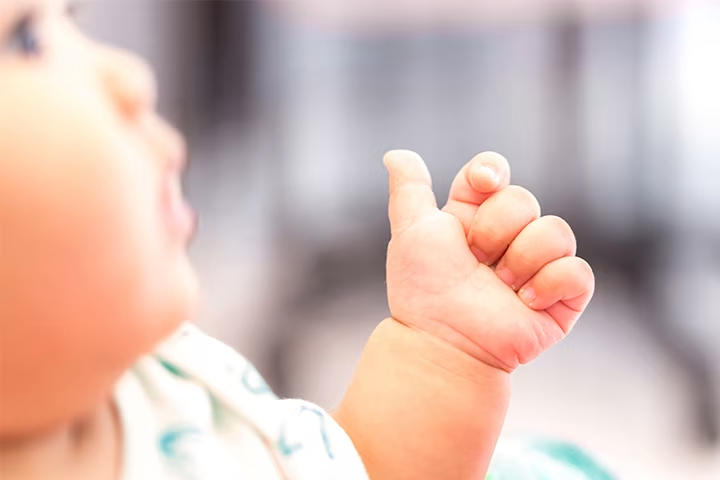
Teaching Baby Sign Language
Teaching baby sign language to your little one is a fun way of communicating with your baby even before he or she is old enough to start talking. Learn more about how to teach baby sign language and what the potential benefits might be.
What Is Baby Sign Language?
Baby sign language has grown in popularity over the past couple of decades. It isn’t the same as the sign language used by people with hearing impairments, but simply a collection of gestures that your baby can use to express simple wants and needs in the months before learning to talk.
For example, you might like to teach your infant the sign language for babies for ‘milk’ or ‘more! ’; but baby sign language doesn’t include the complex phrases and sentences used by people for whom sign language is their main form of communication.
The basic principle of baby sign language is that many babies can be taught to use their hands to ‘talk’ sooner than they can learn speech. Babies are natural mimics and enjoy copying actions and movements. However, they can also learn to interpret and use those gestures to communicate.
In fact, you may already be using gestures to communicate with your child without being aware of it – for example, if you sometimes make an eating motion with your hands to encourage your little one at mealtimes.
You might also already understand the meaning of gestures that your baby makes, such as a ‘pushing away’ action when he or she doesn’t want something – a common non-verbal gesture you might encounter when making the transition to solid foods.
When you teach baby sign language, you’re taking this a step further by building up a ‘vocabulary’ of hand gestures that your baby can use to communicate before gaining the ability to articulate words.
Keep in mind that teaching your baby sign language is optional, and there is no clear evidence that it brings any developmental advantage in the long term.
With that in mind, it’s still a fun tool you could use to communicate with your little one at a time when your baby may have something to say but can’t yet communicate verbally.
Is Baby Sign Language the Same as BSL?
It's important to know that baby sign language is not a form of British Sign Language (BSL) for babies. BSL is the sign language used in the UK by people with hearing impairments to communicate.
In some cases, baby sign language might use modified gestures from British Sign Language (BSL), making it similar but not the same. However, it’s possible to use any signs with your baby, as long as you and your little one know what they mean.
If you have any concerns about your baby’s hearing, talk to your health visitor or doctor, who’ll be able to arrange a hearing test if necessary.
At What Age Should You Start Teaching Baby Sign Language?
You can start teaching baby sign language early in infancy – experts suggest that babies are capable of understanding common words like ‘mummy’ or ‘drink’ by around 6 months old.
Keep in mind, however, that it can take time for babies to get the hang of communicating with baby sign language. If you start teaching basic signs at around 6 to 7 months old, your baby might not start using them to communicate until around 8 or 9 months old, or even later.
How Do You Teach Baby Sign Language?
The good news is that teaching baby sign language to your baby or young toddler isn't that difficult, though the process will require consistent effort, lots of repetition, and patience on your part.
You might like to attend classes – ask your health visitor what’s available in your local area. Besides being enjoyable for you and your baby, they could also offer a great opportunity for networking with other parents.
The signs you learn at baby sign language classes may be adapted from British Sign Language, but if you don’t want to attend classes it’s OK to use your own signs mixed in with the ones that you and your baby invent together.
If you’re making up your own signs, it’s worth knowing that infants find it easiest to learn signs that ‘look like’ their meaning – for example, your sign for drink could look like you’re holding a cup to your mouth.
Whichever approach you choose – organised classes, do-it-yourself or a combination of both – here are some tips for teaching baby sign language to your baby:
What Are the Benefits of Using Baby Sign Language?
Baby sign language can be a useful communication tool for your baby and a fun bonding opportunity for both of you.
Although you’ll probably learn to recognise many of your child’s non-verbal cues anyway – for example, shaking the head or pushing food away – baby sign language gives babies and young toddlers extra opportunities to communicate before they can say their first words.
This may even ease some of the frustration they might feel when they’re not able to say what they feel, want, or need yet.
Besides this, just the extra attention you pay your baby’s non-verbal gestures while teaching baby sign language can help you bond even more by improving communication and understanding between you and your child.
Can Teaching Baby Sign Language Promote or Delay Speech?
There isn’t enough evidence to prove that baby sign language can help promote language development, literacy or cognitive skills.
On the other hand, there’s no evidence to suggest that teaching baby sign language can cause any disadvantages in terms of your child’s development– so there’s no harm in trying out this form of communication if you and your baby enjoy it.
Meanwhile, continuing to talk to your baby while also signing is important so your child doesn’t fall behind in speech development.
Talk to your health visitor or doctor if you have any questions or concerns before starting to teach baby sign language to your baby.
The Bottom Line
Baby sign language can be a playful and effective form of communication between you and your baby in the months before your baby or young toddler is able to express him or herself verbally.
It’s important to keep speaking to your child alongside teaching baby sign language to ensure that his or her speech development stays on track.
If you’ve decided baby sign language is something you’d like to teach your little one, find ways to make it fun and enjoy the shared bonding moments. Be consistent, be patient and stick with it – nothing will compare to the feeling of pride when you see your baby telling you something with a gesture for the first time.
The information in this article is based on the expert advice found in trusted medical and government sources, such as the National Health Service (NHS). You can find a full list of sources used for this article below. The content on this page should not replace professional medical advice. Always consult medical professionals for full diagnosis and treatment.
Read more about Baby
Related Articles
Join Pampers Club and get:







